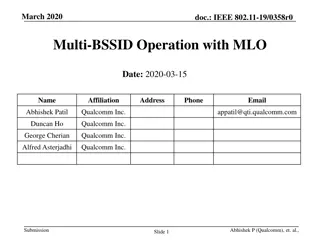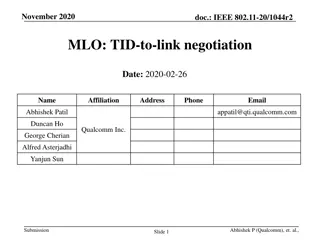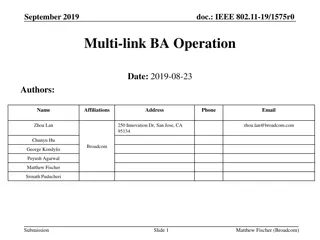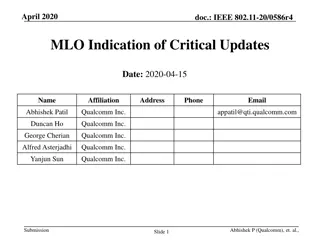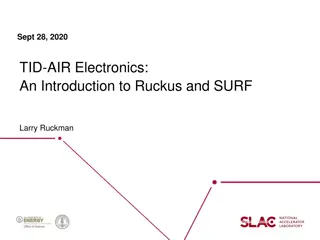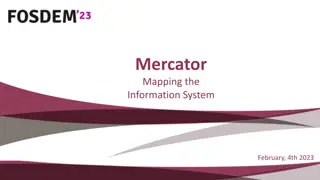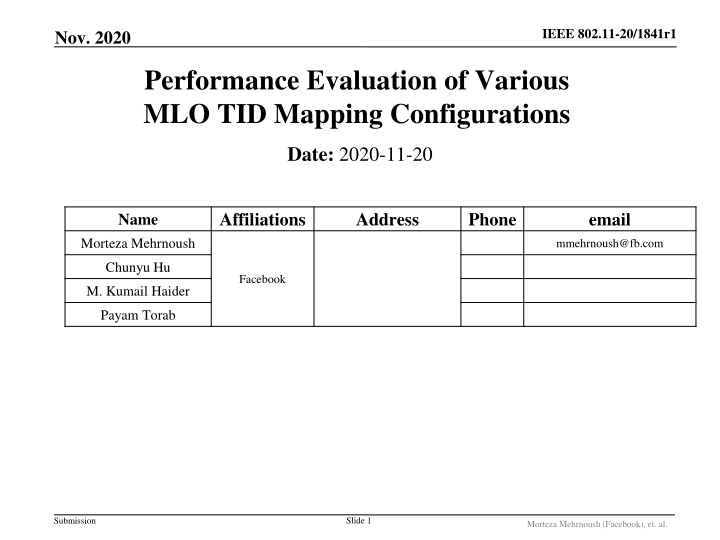
Performance Evaluation of Various MLO TID Mapping Configurations in IEEE 802.11-20/1841r1 Nov 2020
Discover the simulation study on different TID-to-Link mapping configurations, focusing on latency improvement and throughput in IEEE 802.11-20/1841r1 Nov 2020. Explore MLO default TID mapping configurations, simulation results, and in-depth analysis of delay distribution.
Download Presentation

Please find below an Image/Link to download the presentation.
The content on the website is provided AS IS for your information and personal use only. It may not be sold, licensed, or shared on other websites without obtaining consent from the author. If you encounter any issues during the download, it is possible that the publisher has removed the file from their server.
You are allowed to download the files provided on this website for personal or commercial use, subject to the condition that they are used lawfully. All files are the property of their respective owners.
The content on the website is provided AS IS for your information and personal use only. It may not be sold, licensed, or shared on other websites without obtaining consent from the author.
E N D
Presentation Transcript
IEEE 802.11-20/1841r1 Nov. 2020 Performance Evaluation of Various MLO TID Mapping Configurations Date: 2020-11-20 Affiliations Address Phone email Name Morteza Mehrnoush mmehrnoush@fb.com Chunyu Hu Facebook M. Kumail Haider Payam Torab Slide 1 Submission Morteza Mehrnoush (Facebook), et. al.
IEEE 802.11-20/1841r1 Nov. 2020 Introduction MLO supports various TID-to-Link mapping options Conducted a simulation study on various configurations and discuss solution for reducing latency Slide 2 Submission Morteza Mehrnoush (Facebook), et. al.
IEEE 802.11-20/1841r1 Nov. 2020 MLO Default TID Mapping: Config-1 MLO Config-1: all TIDs to all links. Assumed default configuration BA agreement established for each TID is shared over all links Increase throughput, however requires larger BA window to show effect Increase the channel access opportunity expect latency improvement MLO: MLD can use either of the links for transmission Slide 3 Submission Morteza Mehrnoush (Facebook), et. al.
IEEE 802.11-20/1841r1 Nov. 2020 Simulation Study on MLO Default Focus on evaluating the latency improvement in MLO default configuration o STR, asynchronous mode Set-1.a: full buffered UL traffic, all BE, BA win 64 Set-1.b: DL/UL = 80/20 Mbps VI traffic, BA win 64 A 2-link MLO: increase number of non-AP MLDs, 2N Single link: increase number of non-AP STAs, N MAC/PHY parameters: o Fixed PHY rate: mcs9/nss2/bw80MHz o MAC: 2 MSDUs/A-MSDU, rts/cts ON. Evaluate latency by measuring o Total delay: queueing delay + medium contention + transmission delay (including retransmission and response/ack rx time, also include rts/cts and its retrx) Slide 4 Submission Morteza Mehrnoush (Facebook), et. al.
IEEE 802.11-20/1841r1 Nov. 2020 Simulation Results: Set-1.A MLO default has worse latency compared to single link: o Both average and 95% latency are worse and the delta grows as N increases Throughput results are similar Slide 5 Submission Morteza Mehrnoush (Facebook), et. al.
IEEE 802.11-20/1841r1 Nov. 2020 Simulation Results: Set-1.A, Delay CDF A closer examination of the delay distribution MLO: 22 non-AP MLDs Single link: 11 non-AP STAs 80MHz Single-Link MLO Config-1 Tput / user 57.75 Mbps 60 Mbps Avg Delay 89.9 ms 99.62 ms 95% Delay 265.3 ms 291.3 ms Slide 6 Submission Morteza Mehrnoush (Facebook), et. al.
IEEE 802.11-20/1841r1 Nov. 2020 Simulation Results: Set-1.A, RTS TX-PER MLO default has worse RTS PER compared to single link o The reason for higher PER in MLO is that N STAs are contenting over each link in MLO while N/2 STAs are contending in Single-Link o This results in the higher collision and higher PER RTS TX-PER = (CTS RX) / (RTS TX) Slide 7 Submission Morteza Mehrnoush (Facebook), et. al.
IEEE 802.11-20/1841r1 Nov. 2020 Simulation Results: Set-1.B Both Single-Link and MLO achieve the desired UL 20Mbps throughput Observation: o MLO has lower DL delay but also lower throughput when the traffic load exceeds capacity o MLO has slightly better UL delay compared to Single Link o Single Link and MLO achieves the same UL target throughputs o DL traffic load starts to saturate at N=8 for MLO, and at N=10 for Single Link Slide 8 Submission Morteza Mehrnoush (Facebook), et. al.
IEEE 802.11-20/1841r1 Nov. 2020 Key Observations Default MLO TID mapping with two links doubles the channel access opportunity, however, by doing so it incurs higher collision probability and hence can worsen the latency performance (both average and 95%) o As the number of non-AP MLDs increases, average and 95% latency performance gap between the MLO Config-1 and Single Link increases. This shows higher latency in a more congested environment Default MLO TID mapping improves latency when the network has lighter traffic load MLO default can saturate the network load with fewer devices competing the medium Next, we study two other possible MLO TID mapping configuration and seek a better solution for latency improvement Slide 9 Submission Morteza Mehrnoush (Facebook), et. al.
IEEE 802.11-20/1841r1 Nov. 2020 MLO Load-Balancing: Config-2 MLO config-2: all TIDs to a subset of links. Partition links at MLD level: load balancing E.g. a group of non-AP MLDs operate over 5GHz link; and the others on 6GHz link MLO for load-balancing: the non-AP MLDs use the assigned subset of link(s) Slide 10 Submission Morteza Mehrnoush (Facebook), et. al.
IEEE 802.11-20/1841r1 Nov. 2020 MLO Tid-to-Link Mapping: Config-3 MLO config-3: a subset of TIDs to a subset of links. Partition links at TID level E.g. map all BE/BK traffic over the 5GHz link; and the VI/VO traffic on 6GHz link MLO TID/link partition: Traffic is split over the links based on TIDs; MLD tx/rx traffic of subset of TID(s) over a subset of link(s) E.g. Slide 11 Submission Morteza Mehrnoush (Facebook), et. al.
IEEE 802.11-20/1841r1 Nov. 2020 Simulation Study: Set-2 MLO Config-1: MLO Default / all TIDs to all links o 1 AP-MLD with N non-AP MLDs operating on both link 1 and 2 o N/2 MLDs have UL BE saturated traffic; o N/2 MLDs have DL/UL=80/20 Mbps VI traffic MLO Config-2: MLD/link partition o Both links have mixed BE and VI traffic o N/2 non-AP MLDs on link 1, and N/2 non-AP MLDs on link 2 Half of them have UL BE saturated traffic; half have DL/UL=80/20 Mbps VI traffic MLO Config-3: TID/link partition o N/2 non-AP MLDs on link 1: have UL BE saturated traffic o N/2 non-AP MLDs on link 2: have DL/UL=80/20 Mbps VI traffic o MAC/PHY parameters: same as previous set Slide 12 Submission Morteza Mehrnoush (Facebook), et. al.
IEEE 802.11-20/1841r1 Nov. 2020 Simulation Set-2: Throughput MLO Config-3 (TID/Link partition) has highest BE throughput, but lowest VI throughput High BE throughput due to best medium utilization due to large A-MPDU size MLO Config-2 (MLD/Link partition) has highest VI throughput In all Configs, UL achieves the desired 20Mbps throughput Slide 13 Submission Morteza Mehrnoush (Facebook), et. al.
IEEE 802.11-20/1841r1 Nov. 2020 Simulation Set-2: Average Delay MLO Config-1 has highest delay for BE, however lowest delay for VI traffic MLO Config-3 has lowest delay for BE, but highest delay for VI Performance gets penalized by concentrating aggressive traffic over one link Slide 14 Submission Morteza Mehrnoush (Facebook), et. al.
IEEE 802.11-20/1841r1 Nov. 2020 Simulation Set-2: 95% Delay Similar observation as average delay Slide 15 Submission Morteza Mehrnoush (Facebook), et. al.
IEEE 802.11-20/1841r1 Nov. 2020 Analysis (1) Config-3 (TID/link partition) has best BE performance compared with the Config-1 and Config-2, however worst performance for VI traffic o Over link-1 with uniform BE traffic, Config-3 has highest medium utilization: more payloads per frame exchange o Over link 2 with all VI traffic in Config-3, the aggressive EDCA parameters cause more collision and penalize VI performance o In Config-1 (MLO default) and Config-2 (MLD/link partition), BE and VI traffic are mixed over the same link, VI traffic has higher priority over BE and overall Config-2 (MLD/link partition) has a better BE traffic performance compared with Config-1 o Because of fewer VI traffic STAs per-link and less collision in general in Config-2 o Similar observation made in set-1 Config-2 has a better VI traffic throughput but worse delay compared with Config-1 o Throughput: fewer STAs are contending per-link in Config-2, so it results in a lower collision and higher throughput o Delay: since the VI traffic is not a saturated traffic, the STAs in Config-1 can access either of the two links for their transmission so the delay for transmission decreases Slide 16 Submission Morteza Mehrnoush (Facebook), et. al.
IEEE 802.11-20/1841r1 Nov. 2020 Analysis (2) Discussion on better BE traffic performance in Config-3 compared to Config-1 o In Config-1, STAs with BE and VI traffic are contending over both links, so STAs with VI traffic gets priority over the STAs with BE traffic; however, in Config-3, the STAs with VI traffic are contending on one link and STAs with BE traffic on the other link, so the contention is among the same type of traffic and no priority to the VI STAs. o In Config-1 the VI STAs are sending more frames, but since we have a low data-rate traffic of UL=20Mbps and DL=80Mbps, it leads to shorter data frames per tx. o This leads to frequent access of VI STAs and lower medium utilization, so BE STAs gets less channel access opportunities and hence lower throughput o Below is the per STA statistics for N=4 case. In Config-1, we can see more VI tx per second, but each tx has lower aggregation number Config-1 Config-3 traffic #A-MPDUs / second #MPDUs / A-MPDU traffic #A-MPDUs / second #MPDUs/ A-MPDU DL-VI 2640 2 DL-VI 1040 4 UL-VI 500 3 UL-VI 303 4 BE 84 64 BE 320 51 Slide 17 Submission Morteza Mehrnoush (Facebook), et. al.
IEEE 802.11-20/1841r1 Nov. 2020 Summary MLO TID mapping provides flexibility and opportunity to improve latency and also throughput, however the default all TIDs to all link mapping achieve this gain/goal in limited network traffic scenarios. When the network is more congested, default MLO TID mapping has more contention and incurs higher collision which worsens latency and network capacity. MLD/link and/or TID/link partitioning methods are necessary means to reduce this penalty TID/link partitioning method is promising in providing better QoS over each link by grouping traffic of similar requirements/characteristics together, but need additional mechanism to distribute aggressive medium access need scheduling / reserved SPs as necessary compliment mechanism Slide 18 Submission Morteza Mehrnoush (Facebook), et. al.
IEEE 802.11-20/1841r1 Nov. 2020 Backup Slides Slide 19 Submission Morteza Mehrnoush (Facebook), et. al.
IEEE 802.11-20/1841r1 Nov. 2020 Set 1.C Set-1.c: full buffered UL traffic, all BE, BA win 256 o Rest is same as Set-1.A o Higher BA window is to make sure MLD always have packets to contend for accessing over both links MLO default has higher average and 95% latency compared to single link o Consistent with the observation that RTS TX-PER is higher in MLO default case o Throughput results are similar Slide 20 Submission Morteza Mehrnoush (Facebook), et. al.


